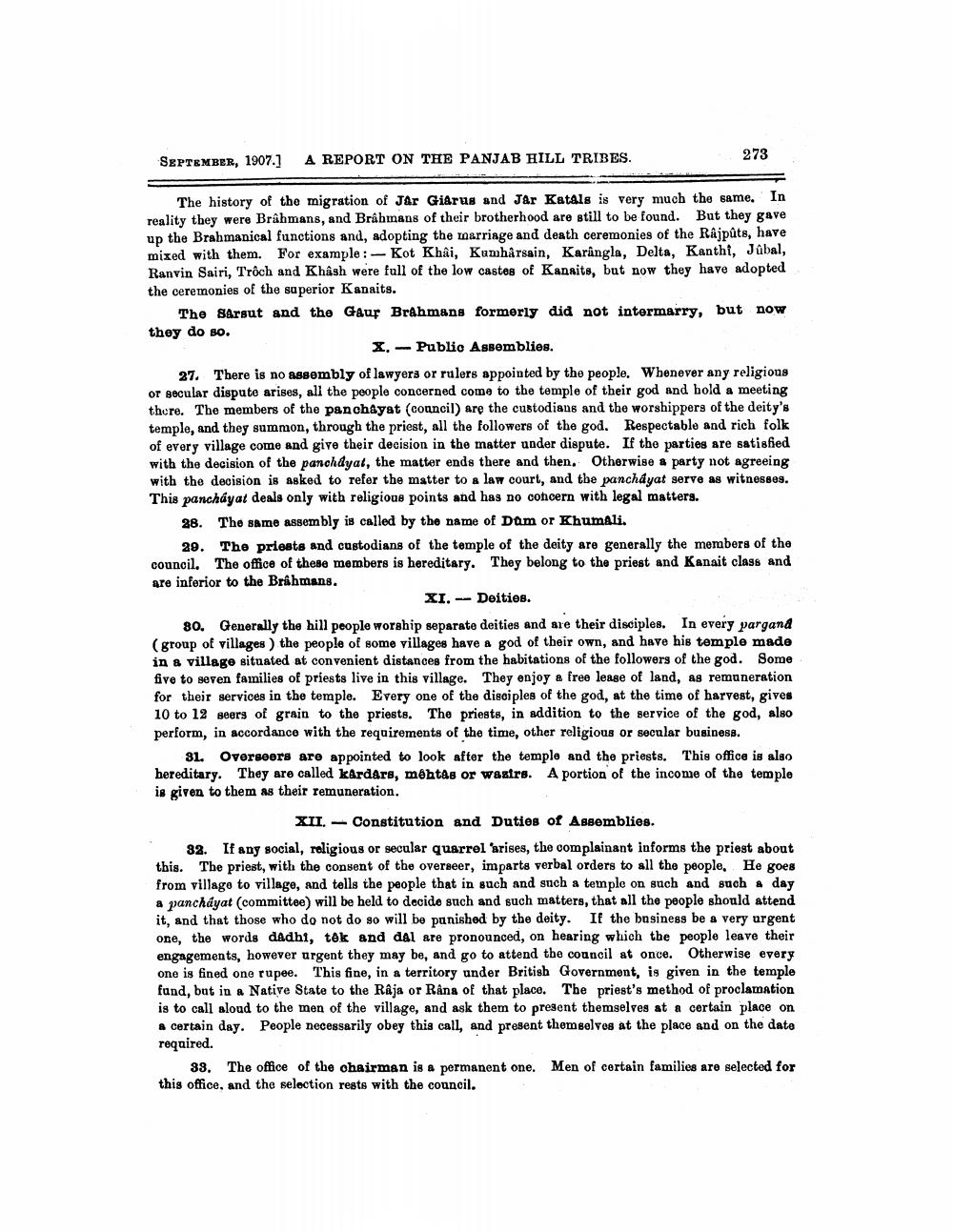________________
SEPTEMBER, 1907.)
A REPORT ON THE PANJAB HILL TRIBES.
273
The history of the migration of Jar Giarus and Jør Katals is very much the same. In reality they were Brahmans, and Brahmans of their brotherhood are still to be found. But they gave up the Brahmanical functions and, adopting the marriage and death ceremonies of the Rajpûts, have mixed with them. For example: - Kot Khải, Kumhårsain, Karangla, Delta, Kanthi, Jûbal, Ranvin Sairi, Trôch and Khâsh were full of the low castes of Kansits, but now they have adopted the ceremonies of the superior Kanaits.
The sarsut and the Gaur Brahmans formerly did not intermarry, but now they do so.
X. - Public Assemblies. 27. There is no assembly of lawyers or rulers appointed by the people. Whenever any religious or secular dispute arises, all the people concerned come to the temple of their god and bold a meeting there. The members of the panchayat (council) are the custodians and the worshippers of the deity's temple, and they summon, through the priest, all the followers of the god. Respectable and rich folk of every village come and give their decision in the matter under dispute. If the parties are satisfied with the decision of the panchdyat, the matter ends there and then. Otherwise a party not agreeing with the decision is asked to refer the matter to a law court, and the panchayat serve as witnesses. This panchayat deals only with religious points and has no concern with legal matters.
28. The same assembly is called by the name of Dam or Khumali.
29. The priests and custodians of the temple of the deity are generally the members of the council. The office of these members is hereditary. They belong to the priest and Kanait class and are inferior to the Brahmans.
XI. -- Deities. 80. Generally the hill people worship separate deities and are their disciples. In every pargand (group of villages ) the people of some villages have a god of their own, and have his temple made in & village situated at convenient distances from the habitations of the followers of the god. Some five to seven families of priests live in this village. They enjoy a free lease of land, as remuneration for their services in the temple. Every one of the disciples of the god, at the time of harvest, gives 10 to 12 seers of grain to the priests. The priests, in addition to the service of the god, also perform, in accordance with the requirements of the time, other religious or secular business.
31. Overseers are appointed to look after the temple and the priests. This office is also hereditary. They are called kardars, méhtas or wastrs. A portion of the income of the temple is given to them as their remuneration.
XII. - Constitution and Duties of Assemblies. 32. If any social, religious or secular quarrel arises, the complainant informs the priest about this. The priest, with the consent of the overseer, imparts verbal orders to all the people. He goes from village to village, and tells the people that in such and such a temple on such and such a day a panchayat (committee) will be held to decide such and such matters, that all the people should attend it, and that those who do not do so will be punished by the deity. If the business be a very urgent one, the words dAdhi, tok and dal are pronounced, on hearing which the people leave their engagements, however urgent they may be, and go to attend the council at once. Otherwise every one is fined one rupee. This fine, in a territory under British Government, is given in the temple fund, but in a Native State to the Râja or Râna of that place. The priest's method of proclamation is to call aloud to the men of the village, and ask them to present themselves at a certain place on a certain day. People necessarily obey this call, and present themselves at the place and on the date required.
33. The office of the chairman is a permanent one. Men of certain families are selected for this office, and the selection rests with the council.




